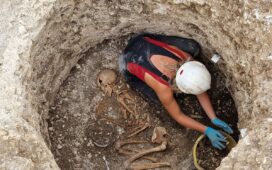Deep in the heart of Microsoft’s sprawling Redmond campus is a building few Microsoft employees, let alone outsiders, have ever seen.
Known only as Building 87, it is home to Microsoft’s hardware design team, and has seen the birth of everything from Microsoft’s Surface tablets and laptops to its Xbox console and controllers.
Dailymail.com was given a rare glimpse inside the lab, where a mini factory churns out prototype parts day and night.
Labs inside the building also run experiments on Microsoft workers, analysing everything from the tiniest movement of their hands as they move a mouse to 3D head scanners using dozens of cameras to capture features to help design headsets.
Scroll down for video


The firm also has a sci-fi like chamber with a single seat at which 36 cameras pointed at a participant to capture their every move and they use products, and a lighting room to recreate the lighting of any room
Within the bowels of the building there are even chambers to recreate light and sound conditions – including the quietest room in the world.
Once through the security, grey slate walls are found throughout, with the only signs of life visible behind highly frosted glass with large ‘no tailgating’ warnings on them.
‘I’ve never been able to give a tour like this before,’ admitted Chris Kujawski, Principal Designer, Microsoft Device Team, as he led Dailymail.com through the building.
The lab was set up to allow Microsoft’s designers to create prototype hardware, and to bring all of the firm’s designers together.
‘We were created this one cohesive brand for Microsoft, so it makes sense to keep them all under one roof,’ Kujawski said.
‘The inspiration you get from other designers really elevates what we do.’
First, he takes us to Microsoft’s ‘human factors’ lab.
John Morris of Microsoft’s human factors design team explained the vast array of lab tests Microsoft subjects employees and outsiders to in order to find out how products ranging from headphones to mice, keyboards and consoles.
Human vision, hearing, speech, tactile sensitivity and emotional response – we cover a wide range of capabilities.
‘We work on every product we make to design them around human, ‘ he said.
‘For instance, we use EEG and eye tracking to work out how stitching between desktop and tablet modes affects our brain’s workload.’
The firm even injects tiny sensors the same size as a human hair into the hand muscles of employees to work out exactly how they are moving when working or playing games.
‘We can find out exactly how much a muscle is contracting, and contracting over time – and use that to make the product better.’
The firm also has a sci-fi like chamber with a single seat at which 36 cameras pointed at a participant to capture their every move and they use products, and a lighting room to recreate the lighting of any room.
‘We need to know all about the variability in the human body so our products will work for all of them.’


Chris Kujawski, Principal Designer, Microsoft Device Team, is shown above with prototypes of the Xbox Adaptive controller
Kujawski even reached for a giant Xbox controller the firm created to give designers an idea of what they felt like to a five year old.
Next on our tour was the prototyping lab, a secretive area where Microsoft builds dozens of prototypes of unreleased gadgets to allow designers to tweak them.
Huge 3D printers were churning out custom made Xbox controllers in full color, while next door a full paint studio.
The 3D printers run day and night to help the designers, and can create objects in both plastic and metal. It creates around 400 parts a day.
Elsewhere, larger machines mill metal prototypes, carbing complex shapes from huge blocks of metal.
‘We believe we have the best prototyping capabilities anywhere in the world.
There’s also a spray painting room to perfect colors, and a textile room where the fabric used for cases and keyboards is perfected.
Data from the lab is then sent directly to production facilities in China for manufacturing.
The building also contains the quietest place on Earth, where Microsoft tests the sounds it machines, from fans to keyboards, make.
‘We have the idea in that room over there, come across the hall, and we can made it here. We can do everything to get to a final product,’ said Kujawski.
‘For instance, the adaptive controller came to life here.
‘We 3D print them, we give them to experts who tell us what we’ve done wrong, and we improve them.’
Kujawski said dozens of Adaptive controllers were made and tested before the design was finalized.
‘We care about every piece of plastic, every circuit board – even those that aren’t going to be seen by people.














